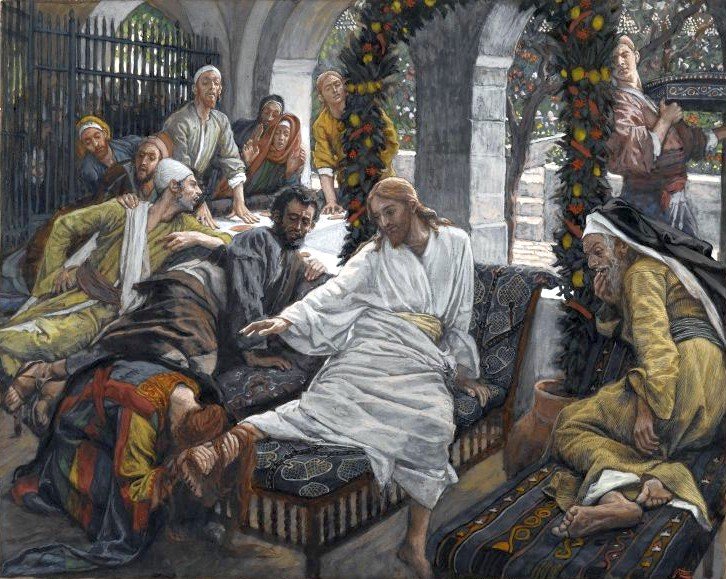
In the past few years, the term “visio divina” has gained traction in the Catholic lexicon. Like “lectio divina,” which is a way to pray with Scripture, “visio divina” translates to “divine seeing” and is a way to pray with art or other visual media alongside Scripture.
I first encountered visio divina in June 2021 at the GIVEN Forum, a conference dedicated to helping young women activate their gifts for the good of the Church and the world. One of the projects inspired by the 2016 forum was Katie Weiss’ Behold, a ministry that uses visio divina to help women to “encounter the beauty of God and themselves, and go forth into the world sharing this beauty.”
During the forum, Katie led the participants through a time of visio divina. She showed us an image of James Tissot’s painting, “The Ointment of the Magdalene.” Then she took us through the following steps (which are also found on her website):
• Visio: We were asked to spend time looking at the image and “praying how it speaks to (our) heart.”
• Meditation: Katie then read us an accompanying Scripture passage (Jn 12:1-10) and invited us to ponder the painting more deeply with the guidance of reflection questions. As one would experience during lectio divina, we were asked: “What strikes you about this image and Scripture?”
• Prayer: We were then invited to enter into dialogue with the Lord about what was speaking to us from the Scripture and painting.
• Contemplation: Katie describes this step as “simply resting in God” and “a time of divine intimacy.”
• Action: The final question of our prayer was, “How can you live out the fruit of this meditation?” The point of this step is that the word we read and the image we gazed upon take root in us and change us, and call us to some kind of response.
Praying with this painting was powerful. I was struck by Mary Magdalene’s utter abandonment before the Lord, as well as the shocked and somewhat disapproving faces of the people around Jesus.
Jesus, however, reaches a hand toward her, perhaps pointing out to those assembled her example of humility. He is not at all embarrassed by the fact that her hair is draped over his feet. In this moment of abandonment, Mary has given all her worldly and spiritual goods to the Lord, and the sweetness of the ointment fills the room.
During the meditation, one of Katie’s questions was: “Does anything hold you back from receiving your gifts?” This led me to ponder areas of fear and lack of trust in my own life and to bring these to prayer, and to discern the action of finding a spiritual director so I could more freely empty my alabaster jar over Jesus’ feet.
In June 2022, I got a chance to sit down with Katie to discuss more deeply her own experiences of praying with art. Before founding Behold, Katie spent time with a religious order discerning her vocation. Though struggling to pray with Scripture alone, she found prayer came more easily before Fra Angelico’s “Annunciation.”
“It gave me permission to feel what I was feeling,” Katie shared. “I was feeling I wasn’t called to the religious community I was with, but I was afraid to see that.” Praying before this painting gave her permission to acknowledge hard feelings — like fear and suffering and, in this instance, the courage to discern out of the religious community.
More recently, art has helped Katie process the profound grief of her miscarriage. An artist herself, she felt called to paint in the weeks following this loss: “I painted this image of Mary holding our baby, Lucy. It was really healing to acknowledge a loss and to express what I was feeling inside.”
Art has been a catalyst for helping Katie grow in intimacy with the Lord, and her ministry is guided by the belief that it can do the same for others. Behold has served post-abortive women and has also offered small group opportunities to pray through the mysteries of the rosary with art and to use hand lettering to pray with a Scripture verse.
Katie describes these experiences of creating or engaging more of the senses while praying with art as incarnational. It is also very much a part of the Catholic tradition — while researching for Behold, Katie found a book on Eastern Catholicism that mentioned the practice of praying with icons and Scripture.
Even stained glass, Katie says, is a visual way to engage with Scripture, and in the early days of its use, would have helped a largely illiterate population engage more deeply with faith.
Since Behold’s launch in 2016, Katie has seen the term “visio divina” explode. She believes that the Holy Spirit is using this way of praying to touch souls.
The beautiful thing about our Church is that it holds a rich treasury of ways in which we can draw close to Our Lord. Visio divina, I’ve found, vibrantly brings the Scriptures to life and invites the viewer to rest in the visual poetry of an artist’s inspiration.









